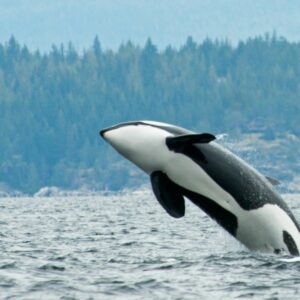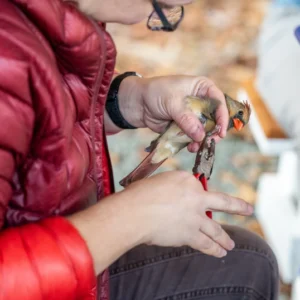Wildlife Curiosities
Nature is full of surprising curiosities. Some are bizarre, others are merely astonishing, but all are fascinating and inspire us with awe. Here are some examples:
- One-quarter of mammals are bats. There are more than 1,300 species of bats in the world. In Canada we have 19 species; 11 are on the endangered list. A single Little Brown Myotis can catch around 1,000 mosquito-size insects in one hour. White-nose syndrome has killed millions of bats across North America. Pesticides and wind turbines haven’t helped bat populations either. Turbines are particularly troublesome for our migratory species like the Hoary, Easter-red, and Silver-haired bats. Not all bat species hibernate in winter. Some of our Ontario bats fly south in the winter, just like birds do.
- A Honey Bee has to travel 88,513 km and visit two million flowers to collect enough nectar to make one pound of honey.
- A dragonfly can fly at a speed of up to 56.3 km/h, making it one of the fastest flying insects in the world. Monarch butterflies are not the only insects migrating over long distances. Each Spring and Fall Green Darner dragonflies fly across North America, travelling some 1,500 km on their five centimeter wings, fluttering from Canada to the Gulf of Mexico. However, they rarely migrate in huge swarms. Dragonflies fly the routes their long-deceased great grandparents did, without communication passed from older generations. The onset of their migration appears to be triggered by changes in temperature and in the amount of daylight.
- A female polar bear will put on over 200 pounds to prepare for her four to five month long food hiatus while she births and cares for her cubs in the den. When spring makes an appearance around March, she and her cubs will emerge from the den. Over the next two and half years, cubs will stick close to their mothers to learn all the survival tips and tricks before they take off on their own.
- Pregnant octopuses will starve themselves in order to protect their eggs! They’ll lay their eggs and guard them for a month; they never abandon them for a second – not even to get food! If females get a little hungry, they’ll just eat one of their own tentacles. Unfortunately, once the eggs have hatched and float away, females often die as they become too weak to defend themselves against predators – the ultimate sacrifice.
- Orcas and Bottlenose Dolphins won’t sleep for as long as a month so they can tend to their calves, which also don’t sleep for a month after they are born.
- Every October, Eastern Pacific Gray Whales begin their two- to three-month long journey from the west coast of Canada to the safer and warmer lagoons in Mexico, where pregnant whales give birth. Calves will feed on nutrient-rich, high-fat milk for three to five months so that the little ones grow strong for the trek back to cold Canadian waters. Mothers will actually grow hungry and lose weight as their calves nurse, but they make this sacrifice, apparently understanding that the Mexican lagoons are truly the safest places for the young to grow.
Sources: Ontario Nature, Canadian Wildlife Federation, Nature Conservancy Canada, World Wildlife Fund-Canada, Toronto Wildlife Centre, National Audubon Society, Toronto Field Naturalists, Environment and Climate Change Canada, and personal field notes
Nature Notes are posted as blogs on the website of Nature Canada. Earlier editions are archived on the websites of the Rouge Valley Conservation Centre and of the Rouge Valley Naturalists.



